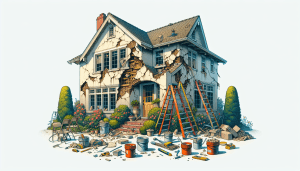Removing home siding can be a daunting task, fraught with potential pitfalls and errors that could cost you time, money, and peace of mind. At Utah Siding & Exteriors, we understand the challenges homeowners face when undertaking such a project. That’s why we’ve compiled this comprehensive guide filled with do’s and don’ts to ensure your Siding Removal process is smooth, efficient, and safe. Whether you’re embarking on a DIY project or preparing for professional assistance, this article is your go-to resource for avoiding common mistakes and making informed decisions about your home’s exterior.
Understanding the Scope of Your Project
Before you dive into the siding removal process, it’s vital to fully understand what you’re getting into. Investigating what type of siding you have and the method of installation will inform your approach and help prevent unnecessary damage to your home’s structure. For example, Vinyl Siding clips into place, whereas Wood Siding may be nailed. Knowing these details ensures you’re removing materials appropriately and safely.
Another critical aspect is determining if you need to replace any underlying structures due to rot or mold. Inspect your home’s exterior carefully before the removal process begins. If you discover underlying damage, this could significantly impact your project’s scope and budget. Proper preparation avoids surprises down the line and ensures a smoother renovation process.
Safety First: Gear Up!
Safety cannot be overstated when it comes to home improvement projects, and siding removal is no exception. Wearing the right gear can protect you from sharp nails, broken siding, and other potential hazards. Essentials include gloves, safety goggles, and sturdy footwear. Don’t overlook the importance of protective clothing; long sleeves and pants can prevent scrapes and cuts.
Additionally, consider the working environment. Ensure your workspace is clear of obstructions and that ladders and scaffolding are secure and stable. Remember, taking the time to set up a safe working environment can prevent accidents and injuries, ensuring that your project proceeds as smoothly as possible.
Preparation is Key
Before you begin the actual removal, preparing the area and your materials is essential. Cover landscaping, outdoor furniture, and any other elements that could be damaged by falling debris with tarps or plastic sheets. It’s not just about protecting your garden; it’s about making cleanup easier.
Furthermore, gather all the tools you’ll need so they’re readily accessible. This preparation includes items like pry bars, hammers, and perhaps a power drill. Having everything at hand not only makes the process more efficient but also helps maintain focus and safety during the project.
Do’s and Don’ts of Technique
- Start from the Top: Begin siding removal at the top of your home and work your way down. This method prevents damage to the siding you’re leaving in place and minimizes the risk of personal injury.
- Avoid Forcing Panels: If a piece of siding doesn’t come off easily, there’s likely a reason. Forcing it can cause breakage and additional damage. Take your time to assess and gently remove each piece.
- Use the Right Tools: Employ specific siding removal tools like a zip tool for vinyl siding to unclip panels safely. Using the wrong tools can damage the siding and your home’s exterior.
- Keep the Area Clean: Regularly remove discarded siding and debris. A clean workspace is not only safer but also allows for a more efficient workflow.
- Seek Help for Large Projects: Don’t be afraid to enlist help for larger siding removal projects. Removing siding can be labor-intensive, and having an extra set of hands can make the process more manageable.
Identifying and Handling Hazards
One of the critical parts of siding removal is identifying and properly handling potential hazards. Asbestos and lead paint are two significant concerns, especially in older homes. If your siding or the paint on it contains these materials, DIY removal is not advised. Special handling and protective measures are necessary to safely remove materials containing asbestos or lead paint.
Another potential hazard is electrical wiring. Be extremely cautious around power lines and electrical boxes. If your siding removal project requires working near these, consider hiring professionals to ensure safety and compliance with local building codes.
When to Call the Professionals
While many homeowners are capable of handling siding removal as a DIY project, there are times when calling in the professionals is the best course of action. This decision is especially true if you encounter hazardous materials, your home is particularly tall or the siding is in a state of severe disrepair. Professional siding contractors have the experience, tools, and safety equipment to handle these challenges efficiently.
At Utah Siding & Exteriors, we’re equipped to address all your siding needs. Our team of skilled professionals is trained to manage any siding removal project, large or small, with precision and safety. Choosing to work with experts can save you time, avoid potential injuries, and ensure that your home’s exterior is in the best hands.
Post-Removal Cleanup and Disposal
Once the siding has been successfully removed, it’s crucial to properly clean up and dispose of the debris. Evidently, siding materials, especially old and damaged pieces, require certain disposal methods to comply with local regulations. Ensure you’re familiar with these guidelines to avoid fines or penalties.
Moreover, the cleanup process isn’t just about throwing away old materials. It’s an opportunity to inspect your home’s structure for any issues that need addressing before installing new siding. Look for signs of rot, insect infestation, or other damages and plan for repairs as necessary.
Avoiding Common Mistakes
| Mistake | Consequence | Solution |
|---|---|---|
| Ignoring Safety Precautions | Potential Injury | Wear Protective Gear |
| Improper Tool Use | Damage to Siding/Structure | Use Correct Tools |
| Forgetting to Check for Hazards | Health Risks | Inspect for Asbestos/Lead |
| Rushing the Process | Unnecessary Damage | Take Your Time |
| Skipping Professional Help When Needed | Potential for Greater Damage | Hire Experts |
The Final Touch: Ensuring Your Home is Ready for New Siding
With the old siding gone, it’s essential to ensure your home is prepared for its new exterior. This preparation includes repairing any structural damage, installing insulation if needed, and ensuring the surface is smooth and clean for the new siding. This final step is crucial for the longevity and performance of your new siding, making it an indispensable part of the renovation process.
Keeping these guidelines in mind, you’re now equipped to tackle your home siding removal project with confidence. Remember, preparation, safety, and proper technique are key to a successful outcome.
We hope this guide has equipped you with the knowledge needed for a successful siding removal process. Thank you for considering Utah Siding & Exteriors for your home improvement needs. For further assistance or to discuss your project in detail, please don’t hesitate to contact us by phone at 801-509-9241 or Request a Free Quote.




